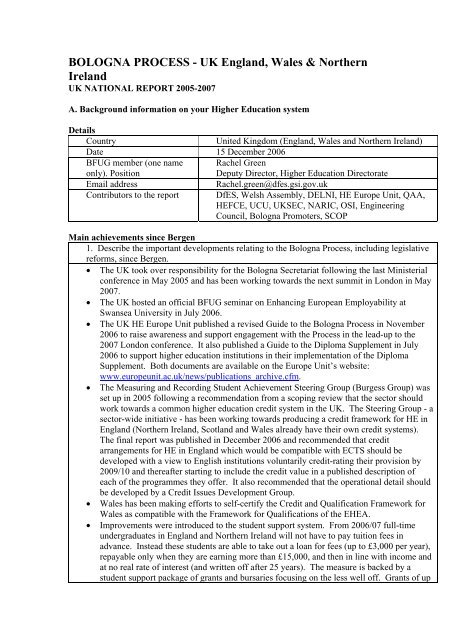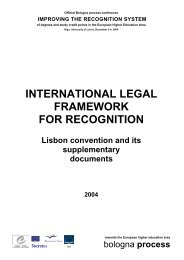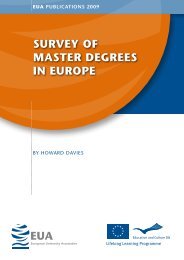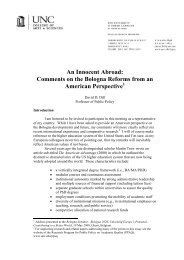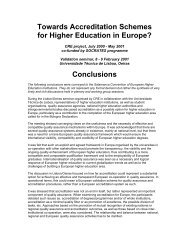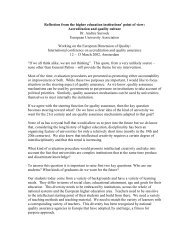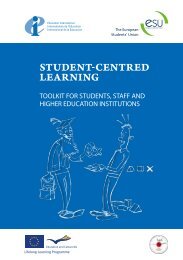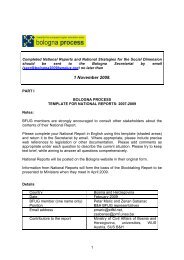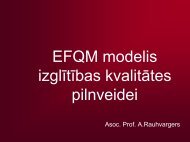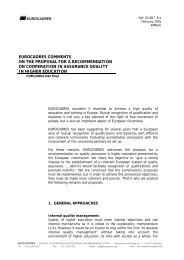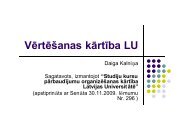BOLOGNA PROCESS - UK England, Wales & Northern Ireland
BOLOGNA PROCESS - UK England, Wales & Northern Ireland
BOLOGNA PROCESS - UK England, Wales & Northern Ireland
Create successful ePaper yourself
Turn your PDF publications into a flip-book with our unique Google optimized e-Paper software.
<strong>BOLOGNA</strong> <strong>PROCESS</strong> - <strong>UK</strong> <strong>England</strong>, <strong>Wales</strong> & <strong>Northern</strong><strong>Ireland</strong><strong>UK</strong> NATIONAL REPORT 2005-2007A. Background information on your Higher Education systemDetailsCountryUnited Kingdom (<strong>England</strong>, <strong>Wales</strong> and <strong>Northern</strong> <strong>Ireland</strong>)Date 15 December 2006BFUG member (one name Rachel Greenonly). PositionDeputy Director, Higher Education DirectorateEmail addressRachel.green@dfes.gsi.gov.ukContributors to the report DfES, Welsh Assembly, DELNI, HE Europe Unit, QAA,HEFCE, UCU, <strong>UK</strong>SEC, NARIC, OSI, EngineeringCouncil, Bologna Promoters, SCOPMain achievements since Bergen1. Describe the important developments relating to the Bologna Process, including legislativereforms, since Bergen.• The <strong>UK</strong> took over responsibility for the Bologna Secretariat following the last Ministerialconference in May 2005 and has been working towards the next summit in London in May2007.• The <strong>UK</strong> hosted an official BFUG seminar on Enhancing European Employability atSwansea University in July 2006.• The <strong>UK</strong> HE Europe Unit published a revised Guide to the Bologna Process in November2006 to raise awareness and support engagement with the Process in the lead-up to the2007 London conference. It also published a Guide to the Diploma Supplement in July2006 to support higher education institutions in their implementation of the DiplomaSupplement. Both documents are available on the Europe Unit’s website:www.europeunit.ac.uk/news/publications_archive.cfm.• The Measuring and Recording Student Achievement Steering Group (Burgess Group) wasset up in 2005 following a recommendation from a scoping review that the sector shouldwork towards a common higher education credit system in the <strong>UK</strong>. The Steering Group - asector-wide initiative - has been working towards producing a credit framework for HE in<strong>England</strong> (<strong>Northern</strong> <strong>Ireland</strong>, Scotland and <strong>Wales</strong> already have their own credit systems).The final report was published in December 2006 and recommended that creditarrangements for HE in <strong>England</strong> which would be compatible with ECTS should bedeveloped with a view to English institutions voluntarily credit-rating their provision by2009/10 and thereafter starting to include the credit value in a published description ofeach of the programmes they offer. It also recommended that the operational detail shouldbe developed by a Credit Issues Development Group.• <strong>Wales</strong> has been making efforts to self-certify the Credit and Qualification Framework for<strong>Wales</strong> as compatible with the Framework for Qualifications of the EHEA.• Improvements were introduced to the student support system. From 2006/07 full-timeundergraduates in <strong>England</strong> and <strong>Northern</strong> <strong>Ireland</strong> will not have to pay tuition fees inadvance. Instead these students are able to take out a loan for fees (up to £3,000 per year),repayable only when they are earning more than £15,000, and then in line with income andat no real rate of interest (and written off after 25 years). The measure is backed by astudent support package of grants and bursaries focusing on the less well off. Grants of up
to £2,700 are available as well as a minimum bursary of £300. Variable tuition fees willbring new income into the HE sector – an extra £1.35bn per year – and are independent ofgovernment decisions about public spending priorities. This means English HEIs canmaintain and improve competitiveness in the global HE market. There is no evidence toindicate that tuition fee contributions have deterred students from entering HE and therehas been no change in the socio-economic background of applicants. These factors arebeing closely monitored because of concerns about the effect of the variable tuition fees onthe uptake of higher education provision, especially by those less well off.• Foundation Degrees have been further developed since the last national report. There arenow around 2,102 courses running with a further 742 planned. Nearly 47,000 studentsstudied for a Foundation Degree in 2005-2006.National organisation2. Describe any changes since Bergen in the structure of public authorities responsible forhigher education, the main agencies/bodies in higher education and their roles.Please include:• whether higher education institutions (HEIs) report to /are overseen by differentministries• how funds are allocated to HEIs• areas for which HEIs are autonomous and self governing.Details of the structure and funding were set out in the previous national report.The Office for Science and Technology within the Department for Trade and Industry has sincebecome the Office for Science and Innovation (OSI); the Teacher Training Agency has becomethe Teacher and Development Agency for schools.<strong>UK</strong> institutions are responsible for deciding for themselves who is admitted to study, what istaught, who teaches, how the institutions are governed, and what strategies they pursue.3. Describe any changes since Bergen to the institutional structure.Please include:• the number of public/private HEIs• are there different types of institutions delivering higher education (i.e.academic/professional, university/non-university etc.)• the number/percentage of students admitted in academic session 2006-2007 to eachtype of institution• the extent to which different types institutions are covered by the same regulations.Details of the number of institutions were provided in the previous national report.In 2004/05 there were 2.2 million students enrolled on higher education courses at publicly funded<strong>UK</strong> higher education institutions, plus a further 200,000 undertaking higher education at furthereducation colleges. Of these: 1,445,000 were mature (25 or over for postgraduates, 21 or over forundergraduates); 896,000 were studying part time.The number of <strong>UK</strong> domiciled students admitted to <strong>UK</strong> Higher Education in 2004–05 (the last yearfor which audited figures are available) was 848,940 (source: Table 10b of the HESA Red Bookon students). Currently the University of Buckingham has 814 students (source: University ofBuckingham website accessed 23 November 2006).Partnership
4. Describe the structure which oversees the implementation of the Bologna Process in yourcountry.Please include:• the membership and role of any national Bologna group (for example policycommittee, promoters’ group)• the membership and role of students, staff trade unions, business and social partners inany national Bologna Group.The specific arrangements were set out in the previous national report, but institutional autonomymeans that implementation of the Bologna principles is primarily a matter for the sector itself.The <strong>UK</strong> HE Europe Unit’s two recent publications, Guide to the Diploma Supplement and UpdateGuide to the Bologna Process, make an important contribution to the implementation of Bolognareforms.In addition to the High Level Policy Forum and European Coordinating Group described in theprevious report, the National Union of Students, the national team of Bologna Promoters andprofessional bodies also participate and inform the policy position of the <strong>UK</strong> HE Europe Unit.Bologna Promoters have been active in the <strong>UK</strong> over the last two years and have assisted <strong>UK</strong>institutions on all aspects of the process.The <strong>UK</strong> has been providing the Bologna Secretariat since May 2005.5. Describe the arrangements for involving students and staff trade union/representativebodies in the governance of HEIs.Please include:• precise references (preferably with web links) to any legislation (or equivalent) in placeto ensure students and staff are represented on HEI governing bodies• the role of students in the governance of HEIs• the role of staff trade union/representative bodies in the governance of HEIs.In <strong>England</strong>, there are no legislative requirements for HEIs to have student and staff representativeson their governing bodies. However, the Committee of University Chairmen produces guidanceon good governance arrangements and recommends that governing bodies should include studentand staff members. All HEIs do have academic staff representatives on their governing bodies;some also have non-academic staff members. The vast majority of institutions have studentmembers on their governing bodies. Membership of the governing body will be laid down in theinstitution’s governing documents. Student and staff members are full members of the governingbody with full voting rights. The Higher Education Funding Council for <strong>England</strong> (HEFCE) Guidefor Members of Higher Education Governing Bodies in the <strong>UK</strong>(www.hefce.ac.uk/pubs/hefce/2004/04_40a ) encourages the adoption of open practices by governing bodies.HEFCE advises that staff and student representatives are fully involved in governing bodies and their expertise fullydrawn on. The inclusion of staff (and student) representatives in decision making adds considerably to the authorityand transparency of the decisions reached.6. Describe the measures in place to ensure the co-operation of business and social partnerswithin the Bologna Process.The Department for Education and Skills’ strategy is one of HE sector growth through employerledprovision. The HEFCE strategy on employer engagement(http://www.hefce.ac.uk/learning/employer/strat/) reflects this, defining ‘employer engagement’ interms of the broad range of collaborations existing between HE and public and private sectororganisations (as explored by the Lambert Report on Business-University Collaboration, 2003).The focus of this employer engagement strategy is on teaching and learning although it has links
with knowledge transfer and with widening participation. The 2005 HE Business and CommunityInteraction Survey (www.hefce.ac.uk/reachout/hebci/) showed that the HE market for business inthe community, continuing professional development, and continuing education totalled some£298 million in 03/04.HEFCE’s approach is to respond to the Government’s skills strategy by seeking to makeeducational provision more responsive to employers’ needs, with a particular focus onemployability.HEFCE issued a call to institutions in May 2006 for proposals to pilot innovative, employer-ledprovision (Employer Engagement Pilot Proposals). These will provide evidence on whatinstitutions require to respond flexibly to employers, and on exemplary models of learning thatfulfil employers’ and learners’ needs.The Government is also taking steps to encourage the embedding of work-related skills widely inHE provision by introducing measures that promote partnership working between HE institutionsand employers. For instance, initiatives like Higher Education Skills Train to Gain Pathfinders,part of a national training programme offering employers impartial advice and easy access toquality training, and Sector Skills Councils address skills gaps at HE level and allow employers tocontribute to the cost of training.Sector Skills Councils are strategic employer-led bodies leading the drive to improvecompetitiveness and productivity in industry and business sectors across the <strong>UK</strong>. They work withemployers, trade unions, professional bodies, trade associations and government to identify skillsand productivity trends within their sector, and to establish priorities for investing in the skills ofthe sector workforce, including the development of apprenticeships, higher education and nationaloccupational standards. They are developing Sector Qualification Strategies to shape andinfluence qualifications education/training at all levels, including higher level and FoundationDegrees.B. Main stocktaking questions, including scorecard elementsDegree system(Scorecard and Eurydice)Stage of implementation of the first and second cycle7. Describe the progress made towards introducing the first and second cycle.Please include:• the percentage of the total number of students below doctoral level enrolled in the twocycle degree system in 2006/07.The <strong>UK</strong> degree system is based on 3 main cycles (Bachelors/Masters/Doctorate). IntegratedMasters degrees of four to five years’ duration exist in engineering and some scientific disciplines.These have been designed to allow fast-track progression to the highest professional status andincorporate second cycle learning outcomes which have been agreed by the academic communityand the professions. Extensive work has been done to develop clear expected learning outcomesfor all engineering degrees, relating to the Quality Assurance Agency’s (QAA) qualificationdescriptors and hence to the Dublin descriptors. These have been adopted both as the QAAsubject benchmark statement and as the profession’s requirements for professional accreditation.In 2004/05, 4% of students were studying doctorates, 13% were studying for mastersqualifications, 7% were studying for other postgraduate qualifications (including PGCEs), 54%were studying for 1 st degrees and 23% were studying for sub degree qualifications. In <strong>Northern</strong>
(Scorecard and Eurydice )Access 1 to the next cycle9. Describe the arrangements for access between the first and second cycles and second andthird cycles.Please include:• the percentage of first cycle qualifications that give access to the second cycle• if appropriate, the percentage of first cycle qualifications that give access to the thirdcycle• the percentage of first cycle qualifications that give access to both the second and thirdcycles• the percentage of second cycle qualifications that give access to the third cycle• specify any first cycle qualifications that do not give access to the second cycle• specify any second cycle qualifications that do not give access to the third cycle.• specify any examples where bridging courses are necessary to transfer between cyclesin the same subject area• any measures planned to remove obstacles between cycles.The successful completion of a first cycle qualification gives access to the second cycle, so thepercentage of first cycle qualifications that give access to the second cycle is 100%. Successfulcompletion of second cycle qualifications gives access to the third cycle. The large majority ofstudents complete a second cycle before starting a doctorate, but in some subjects, <strong>UK</strong> HEIs allowaccess to doctoral programmes without prior completion of a Masters degree. There are no first orsecond cycle qualifications which do not give access to the next cycle.(Scorecard and Eurydice )Implementation of national qualifications framework10. Describe the stage of implementation of the national qualifications framework to alignwith the overarching Framework for Qualifications of the EHEA 2 .Please include:• the stage of development of your national qualifications framework (for example: hasyour national QF been included in legislation or agreed between all relevantstakeholders; has a working group been established; have national outcomes-baseddescriptors of the main types of qualifications been prepared; has a timetable forimplementation been agreed?)• the extent to which your national qualifications framework is in line with theFramework for Qualifications of the EHEA• the role of stakeholders in the development of your national qualifications framework.Universities in the <strong>UK</strong> are autonomous and award their own degrees and qualifications. The1 Access as defined in the Lisbon Recognition Convention. Access: the right ofqualified candidates to apply and be considered for admission to higher education.2 A Framework for Qualifications of the EHEA: http://www.bologna-bergen2005.no/
FHEQ provides descriptors for five levels of HE qualifications (three at undergraduate level andtwo at postgraduate), including short cycle awards within the first cycle as well as descriptors forBachelor, Master and Doctoral degrees. All qualifications are described in terms of learningoutcomes. Guidance is also provided on the nomenclature of awards. In these respects the FHEQis broadly in line with the overarching framework for qualifications in the EHEA.11. What measures are being taken to increase the employability of graduates with bachelorqualifications?Please include where possible:• the percentage of first cycle graduates who found employment after graduating in2005/06• the percentage of first cycle graduates who continued into the second or third cycles in2005/06• the extent to which this is expected to change in 2006/2007.Enhancing the employability of graduates is a key part of the Government’s White Paper ‘Thefuture of higher education’ (Cm 5735) which states that ‘as well as improving vocational skills,we need to ensure that all graduates, including those who study traditional academic disciplines,have the right skills to equip them for a lifetime in a fast changing work environment’. Toimprove both graduate employability and the relevance of graduate skills to the economy, alluniversities are embracing the skills agenda, recognising the key part they have to play both inpreparing the technical and professional workforce of the future, but also in terms of continuingprofessional development. The HE Academy has stimulated considerable engagement to createvocational progression frameworks, influence the shape of new specialist diplomas at level 3 andof Foundation Degrees, accredit industry skills, find willing employers to engage in HEcurriculum design, produce shared resources for vocational learning, research industrycompetences and employer expectations. This has been particularly successful in the subject areasof Art, Design and Media, and in Construction. It is also actively supporting entrepreneurial andenterprise education through close work with the National Council for Graduate Entrepreneurship.The undergraduate curriculum frequently includes placements, projects, skills and enterprisemodules, simulations and other work-related components to generate higher level skills. Extracurricularactivities are also widely supported, such as volunteering and work experience, forwhich credit or additional certification is frequently available. Personal Development Planning(PDP), which is a process undertaken by an individual to reflect upon their own learning,performance and/or achievement and to plan for their personal, educational and careerdevelopment, is now a requirement for all HEIs. This not only helps students to developknowledge about themselves and through this build a stronger sense of identity, but also improvestheir ability to relate their learning and achievements to employers' interests and needs. TheGovernment has asked HEFCE to produce an employer engagement policy designed to impressupon HEIs the need to recognise that all programmes and training courses should offeremployability enhancing skills, through the application of learning and the transfer anddevelopment of underpinning skills and knowledge. Information is collected by the HigherEducation Statistics agency through an annual survey. This shows the destinations of <strong>UK</strong> and EUdomiciled students six months after graduating. The latest figures for first degree graduates in2004/05 are: 64% are in employment, a further 9% are in employment and further study and 24%are in further study only. Of those students in ‘further study only’ or ‘further study andemployment’, 61% were aiming for a higher degree, 17% were studying for professionalqualifications, 18% were studying for other qualifications (including 1 st degrees, diplomas andcertificates) and 5% were not aiming for a qualification. We do not model the future destinations
flows of graduates.Quality assurance(Scorecard and Eurydice)National implementation of the Standards and Guidelines for QA in the EHEA 312. To what extent is your national system of QA already in line with the Standards andGuidelines for QA in the EHEA?Please include:• the stage of implementation of the national quality assurance system in line with theStandards and Guidelines for QA in the EHEA• any action that has been taken to ensure that the national quality assurance system is in linewith the Standards and Guidelines for QA in the EHEA• any deadlines set for taking action to ensure that the national quality assurance system is inline with the Standards and Guidelines for QA in the EHEA• any action planned to ensure that the national quality assurance system is in line with thestandards and guidelines for QA in the EHEA.A description of the quality assurance system in the <strong>UK</strong> and the activities of the QualityAssurance Agency (QAA) was set out in the previous report. QAA has carried out an extensivemapping exercise on the relationship of the European Standards and Guidelines (ESG) to theAcademic Infrastructure for quality and standards, comprising the FHEQ, subject benchmarkstatements, the Code of Practice, QAA principles, policies and audit and review processes. Alldemonstrate broad alignment with the ESG for internal and external QA. As elements of theAcademic Infrastructure are reviewed and revised (normally on a five year basis), explicitreference is made as appropriate to the ESG and other Bologna instruments such as the frameworkfor qualifications. For example, Section 7 of the Code of Practice – Programme design, approval,monitoring and review was reviewed in 2006 and the revised version (September 2006) includesreferences to European developments. The Handbook for the revised institutional audit process in<strong>England</strong> and <strong>Northern</strong> <strong>Ireland</strong> (2006) also makes explicit reference to the ESG as one of theexternal reference points for quality of provision and academic standards of awards. The <strong>UK</strong> HEEurope Unit will produce a note on ESG once the QAA mapping process is complete.(Scorecard and Eurydice)Stage of development of external quality assurance system13. Describe the quality assurance system operating in your country.Please include:• the stage of implementation of your external quality assurance system• the scope of your external quality assurance system: does it operate at a national level;does it cover all higher education 43 http://www.enqa.net/files/BergenReport210205.pdf
• which of the following elements are included in your external quality assurancesystem:o internal assessmento external reviewo publication of results• whether procedures have been established for the peer review of the nationalagency(ies) according to the Standards and Guidelines for QA in the EHEA.In addition to the activities mentioned in the previous report, QAA reviews also cover <strong>UK</strong> highereducation provision delivered outside the <strong>UK</strong>. QAA institutional audit and review processesinvolve the use of materials prepared by institutions, including the outcomes of internal reviews,visits by external reviewers and the publication of (full) reports. QAA’s institutional audit processwas reviewed as part of the review of the Quality Assurance Framework for higher education in<strong>England</strong> in 2005. QAA will ensure that a peer review according to the ESG will take place before2010, most probably during the 2008/2009 academic year.(Scorecard and Eurydice)Level of student participation14. Describe the level of student participation in your national quality assurance system.Please include:• whether students are included in the following aspects of quality assurance:o the governance of national agencies for QAo as full members or observers in external review teamso as part of the decision making process for external reviewso in the consultation process during external reviews (eg arrangements forexternal reviewers to consult with students)o in internal evaluations.Currently the QAA Board of Directors has a student observer member nominated by the NationalUnion of Students (NUS) or the National Postgraduate Committee (NPC) on an alternating basis.Students play an important part in the institutional audit process (<strong>England</strong> and <strong>Northern</strong> <strong>Ireland</strong>)by submitting a written submission (the SWS – student written submission) to brief the externalaudit team. Guidance to student representatives in respect of audit and in addition to the auditHandbook (2006) is provided by a separate publication “Institutional audit – a guide for studentrepresentatives” and through events run in conjunction with the NUS in the Quality Takes Timeproject (www.officeronline.co.uk/stadia/externalpartners/270162.aspx). Student representativesare invited to meetings at all stages of the audit process. The Quality Takes Time project alsotrains student representatives to be effective in internal review processes as this is where mostprogramme evaluation and review takes place in the <strong>UK</strong>.QAA also has dedicated student liaison officers who meet regularly with NUS and NPC. Thisyear an overview report on the findings from institutional audits on the experience of internationalstudents was published in the QAA’s Outcomes publications series.4 higher education: all types of courses of study or sets of courses of study, training ortraining for research at the post secondary level which are recognised by the relevantauthorities as belonging to a country’s higher education system.
QAA will explore with NUS and NPC the possibility of students participating in external reviewteams. Representatives of the student bodies (in addition to the Board observer) will participate inthe QAA Board meeting in March 2007, to consider this proposition further.In 2005 the first full scale National Student Survey was completed. The Survey gathers feedbackon the quality of students' courses to help inform the choices of future applicants to highereducation, and to contribute to public accountability. Its results are an essential element of therevised quality assurance framework for higher education. The second survey (2006) is nowcomplete and shows that 80% of students are satisfied with their higher education courses. Plansare under way for the 2007 survey.(Scorecard and Eurydice)Level of international participation15. Describe the level of international participation in your national quality assurance system.Please include:• whether there is international participation in the following aspects of quality assuranceo the governance of national agencies for quality assuranceo the external evaluation of national quality assurance agencieso teams for external review, either as members or observerso membership of ENQAo membership of any other international network.QAA is a member of ENQA – the Chief Executive Officer is currently President of theassociation. The Agency is also a member of INQAAHE and is an observer of the Asia PacificQuality Network (APQN). QAA has bilateral links and agreements with partner agencies inDenmark, <strong>Ireland</strong>, Malaysia and South Africa, reflecting various levels of interest in sharinginformation about the transnational activities of <strong>UK</strong> HEIs and cooperating in international qualityassurance and evaluation projects. The Agency manages a programme of visits and seminars forinternational colleagues and policy makers with an annual average of 55 delegations.Changes to the Board of Directors of QAA have been made since 2005. The current membershipof the QAA Board of Directors includes two non-<strong>UK</strong> nationals from outside Europe, twoobservers who are not <strong>UK</strong> nationals, a member of the European Space Agency, an AdjunctProfessor at a Hong Kong university and committee and board members at Italian and Portugueseuniversities. QAA does not use or appoint reviewers on an ad hoc basis. QAA recruits auditorsand reviewers through public advertisement on its website and by circulating the advertisementthrough correspondence with heads of institutions. QAA is committed to the principle of equalopportunities and has a policy to ensure that all people are recruited according to their ability tofulfil the requirements for their role. There is no discrimination on the grounds of race, colour,creed, ethnic or national origins, nationality, age, gender etc. All nominees recruited to join thepool from which audit and review teams are selected have to attend a residential training courseand seminars for reviewers and be available, if requested, to participate in three audits over a twoyear period. QAA has non-<strong>UK</strong> nationals in the pool of reviewers, but this was not the criterion forselecting them. The next QAA auditor training course to be held in February 2007 will includeinternational participants from Europe and QAA cooperation partners. The external peer reviewof QAA has not yet taken place but it is expected that it will include international participation.
Recognition of degrees and study periods(Scorecard and Eurydice )Stage of implementation of Diploma Supplement16. Describe the stage of implementation of the Diploma Supplement in your country.Please include:• the percentage of students graduating in 2007 who will receive a Diploma Supplement• which of the following apply to Diploma Supplements issued in your country:o issued in a widely spoken European languageo free of chargeo automaticallyo correspond to the EU/CoE/UNESCO Diploma Supplement format.The <strong>UK</strong> is fully committed to meeting the Bologna Process objective that every student shouldreceive the Diploma Supplement (DS) automatically and free of charge. The <strong>UK</strong> NationalEuropass Centre (NEC) promotes the DS within the <strong>UK</strong>, working with key sector bodies andNational Agencies in the Socrates Programme to provide essential information and guidance insupport of the sector’s progress to full implementation. It will continue to do so under the newLifelong Learning Programme. The <strong>UK</strong> HE Europe Unit is also advising HEIs on issuing theDiploma Supplement (DS) in the <strong>UK</strong>. The results of a survey of <strong>UK</strong> HEIs in 2005 indicated thataround one third of survey respondents currently issue the DS and that 50% had plans to do soover the next two years. Seminars involving representatives from higher education institutionssuggest that there is increasing involvement with the DS in the <strong>UK</strong>. Many institutions havehowever experienced practical difficulties and are delaying the issue of the DS until they nextupgrade their electronic information systems and have the technical capacity to undertake the task.The DS is issued in a widely spoken language and free of charge. Many HEIs are following theEU/CoE/UNESCO format for the DS. In many cases this will be in combination with anotherdocument issued to students in the <strong>UK</strong>, the Transcript element of the HE Progress File whichcontains overlapping information. A <strong>UK</strong> wide Steering Group is currently considering how tosupport the sector’s implementation of the DS/Transcript. The <strong>UK</strong> HE Europe Unit has issued a‘Guide to the Diploma Supplement’ and is planning another survey of HEIs in 2007 which willinclude questions on the DS.(Scorecard)National implementation of the principles of the Lisbon Recognition Convention17. Describe the stage of implementation of the main principles and later supplementarydocuments 5 of the Lisbon Recognition Convention.Please include:• whether your country has ratified the convention (including depositing ratificationinstrument at either CoE or UNESCO)• whether all appropriate legislation complies with the legal framework of the5Recommendation on the Criteria and Procedures for Recognition (2001);Recommendation on the Recognition of Joint Degrees (2004); Code of Good Practicein the Provision of Transnational Education (2001)
Convention and the later Supplementary Documents• which of the following principles are applied in practiceo applicants’ right to fair assessmento recognition if no substantial differences can be proveno demonstration of substantial differences, where recognition is not grantedo provision of information about your country’s HE programmes and institutions• whether you have a fully operational ENIC• any action being taken to ratify or fully implement the Convention and the laterSupplementary Documents.The <strong>UK</strong> ratified the Lisbon Recognition Convention on 23 May 2003 and it came into force on 1July 2003. The Code of Practice of the <strong>UK</strong> National Recognition Information Centre (NARIC)includes recognition measures which are in accordance with the Supplementary Documents. Allof the following principles of the Convention are applied in practice: applicants’ right to fairassessment; recognition if no substantial differences can be proven; demonstration of substantialdifferences where recognition is not granted; provision of information about the country’s HEprogrammes and institutions. The <strong>UK</strong> NARIC is a fully operational representative agency in thewider European Network of Information Centres.(Scorecard and Eurydice)Stage of implementation of ECTS18. Describe the credit and accumulation system operating in your country.Please include:• the stage of implementation of ECTS in academic year 2006/2007• the percentage of first and second cycle programmes using ECTS in academic year2006/2007• how any other credit or accumulation system in use relates to ECTS: is it compatiblewith ECTS; what is the ratio between national and ECTS credits.The <strong>UK</strong> believes that the Bologna process does not specifically require ECTS but a credit systemthat is ECTS compatible. While many English universities and colleges have for many years beenusing credit accumulation within their institution, often in modular degree structures, as well asaccepting transfer students, there has not been a national credit framework for higher education in<strong>England</strong> along the lines of those in other parts of the <strong>UK</strong>. With the publication of the Burgessreport in December 2006, this position will change and <strong>England</strong> will begin to work towards acredit framework that aligns with that of Scotland and <strong>Wales</strong>. The proposed credit framework for<strong>England</strong> will operate on the same metrics as those in other parts of the <strong>UK</strong>, so that 1 ECTS creditwould equal 2 English/Welsh/Scottish credit points. Institutions can and do use ECTS, generallyfor transfer and student mobility purposes within European programmes rather than accumulation.It is not possible to say what percentage of first and second cycle programmes are using ECTS inthe 2006/07 academic year as institutions do not have to report on how they structure theirprogrammes and using ECTS is not compulsory. The Erasmus data suggests that 63.2% of <strong>UK</strong>outward Erasmus students make use of ECTS.19. Has your country produced a national plan to improve the quality of the process associated
with the recognition of foreign qualifications 6 ? If so, give a brief description of the plan andattach a copy.As a party to the Lisbon Recognition Convention the <strong>UK</strong> has in place a robust system for therecognition of international qualifications. The attached <strong>UK</strong> national action plan reports on thecurrent status in detail and describes proposed measures for further qualitative improvements tothe process. The number of international students in the <strong>UK</strong> at all levels is an indication of defacto academic recognition of qualifications from a wide range of systems and countries.Lifelong Learning(Scorecard)Recognition of prior learning20. Describe the measures in place to recognise prior learning, including non-formal andinformal learning.Please include:• the stage of development of any procedures or national guidelines to recogniseprior learning• a description of any procedures or national guidelines for assessing prior learningas a basis for access to HE• a description of any procedures or national guidelines for allocating credits as abasis of exemption from some programme requirements.There is no significant change since the previous report. The QAA guidelines of accreditation ofprior learning can be found at www.qaa.ac.uk/academicinfrastructure/apl/APL.pdf21. Describe legislative and other measures taken by your country to create opportunities forflexible learning paths in higher education.Please include:• any flexibility in entry requirements• any flexible delivery methods• any modular structures of programmes.The Government announced in its HE White Paper of 2003 that it would set up a series of pilotprojects to develop and test accelerated provision in order to respond to the increasingly diversenature of students and their learning needs, and the need for more flexible and inclusive forms ofhigher education. In response, HEFCE has allocated £3 million from its Strategic DevelopmentFund to support the general development of flexible learning through a series of pilot projects,focusing on a range of models. There are currently 5 pilot projects (‘Flexible LearningPathfinders’), based in 4 HEIs (Derby, Leeds Metropolitan, Northampton and Staffordshireuniversities) and a partnership of 3 HEIs: Kent, Greenwich and Canterbury Christ ChurchUniversity. The pathfinders are concentrating on flexibility in terms of variation in pace andintensity of study, combined with flexibility in method of delivery, and underpinned by creditsystems, APL and APEL. Examples of the models HEFCE supports are:6 ENIC/NARIC has produced guidelines for National Action Plans for Recognition.
• accumulation of learning in 'blocks' and the ability to break off and resume studyingwithout having to repeat learning• accelerated study, such as the compressed two-year honours degree, with a differentpattern of terms and shorter holidays• flexible models of part-time study• 'mode-free' study or the ability to vary pace/switch between modes• corporate and work-based learningMany of the programmes being piloted are modular in structure. Entry requirements varyaccording to the nature of the programme and practices within specific HEIs. Generallyrequirements for entry to accelerated 2-year honours degree programmes would be the same as forentry to traditional 3-year degrees. Two-year compressed degrees last for the whole calendar yearso that the learning outcomes are comparable to those from traditional degrees. There are nolegislative barriers to institutions developing more flexible methods of delivery (as HEIs areautonomous bodies): the (private) University of Buckingham, for example, has been offering 2-year accelerated degrees for many years.Other models of flexible learning being piloted (eg work-based learning degrees, tailoredcorporate learning, blended-learning/accelerated/decelerated/foundation degrees) offeropportunities for the entry into HE of non-traditional students.Joint degrees(Scorecard and Eurydice)Establishment and recognition of joint degrees22. Describe the legislative position on joint degrees in your country.Please include:• the stage of implementation of any legislation to establish joint programmes• whether joint 7 degrees are allowed and encouraged in legislation• whether joint degrees are allowed and encouraged in all three cycles• an indication of the percentage of HEIs that have established joint programmes andare awarding nationally recognised degrees jointly with HEIs of other countries• any action being taken to encourage or allow joint programmes.The information provided in the previous report is still current. There is no single model oforganisation for joint degree programmes. Roles and responsibilities in respect of admissions andthe assessment of student learning are negotiated between partner organisations. There is howeverincreasing awareness of the complexities of working across different legal jurisdictions withdifferent student rights and institutional liabilities. There are double and joint degrees atundergraduate (first cycle) and second cycle (Masters) in a number of institutions and also splitsiteor joint supervision of PhDs. There is also increasing activity in respect of members of globalHE consortia offering joint degrees within a wider framework of cooperation activities.7 a joint degree is a single degree certificate awarded by two or more institutions, andwhere the single degree certificate is valid without being supplemented by anyadditional national degree certificate.
Programmes are usually organised between individual institutions at their own initiative, althoughthere has been government support for dual and joint degrees through cooperation programmeswith Russia (BRIDGE) and India (<strong>UK</strong>IERI). A number of <strong>UK</strong> universities have also takenadvantage of the French co-tutelle model for doctoral students. The <strong>UK</strong> is represented in anumber of the Erasmus Mundus Consortia.C. Current issues in Higher EducationHigher education and research23. Describe the relationship between higher education and research in your country - whatpercentage of research is carried out in HEIs; are any steps being taken to improve the synergybetween HE and other research sectors.A high percentage of <strong>UK</strong> universities incorporate a proactive approach to research as an integralpart of their university mission. In 2004-05 there were 152 institutions offering doctoral orresearch programmes in the <strong>UK</strong>. About 20% of total HE funding is allocated for research(including doctoral programmes).24. What percentage of doctoral candidates take up research careers; are any measures beingtaken to increase the number of doctoral candidates taking up research careers?The 2004 Higher Education Statistics Agency report ‘What do PhDs do?’ analysed the HESA firstdestination survey statistics for doctoral graduates in 2003. It calculated that 36% (1375 of3765) of <strong>UK</strong>-domiciled respondents working in the <strong>UK</strong> work in research occupations. TheGovernment has introduced, through the Research Councils, a series of measures aimed atencouraging employers to improve the attractiveness of research careers and to support thetraining and development offered by universities and research organisations. As a result, a numberof recommendations from the Roberts Review into a supply of science and engineering skills inthe <strong>UK</strong> (SET for Success 2002) has been implemented, including some specifically aimed atimproving conditions for postdoctoral researchers, eg increasing Research Council-supportedpostdoctoral researchers’ salaries by around £4,000 by 2005/06 and PhD stipends to £12,000 by2005/06 and to £13,000 in areas of recruitment difficulties; providing two-weeks of careerdevelopment training for Research Council researchers and PhD students; and the development ofa new Academic Fellowship scheme to provide 1,000 fellowships over five years. Two rounds ofAcademic Fellowship awards have now been made, with applications for nearly 2000 fellowshipsfor the 800 available. The 800 awards have been made to 79 universities covering all fields ofresearch activity. The funding for skills training for postdoctoral researchers has enableduniversities to expand their training and support for postdoctoral researchers considerably and toprovide them with opportunities to develop broader professional skills. In addition to this training,the Research Councils operate schemes and targeted training aimed at providing researchers withbroader training, which include public engagement training and the provision of grants for publicengagement activities.Work is currently underway to develop a framework for the employment and management ofresearchers, through the review of the existing Concordat for the management of research staff(1996), with a view to replacing it with a fuller code of practice reflecting current legislation aswell as the European Charter and Code of conduct for the recruitment of researchers. The <strong>UK</strong> HEsector working group, co-ordinated by Universities <strong>UK</strong> and Research Councils <strong>UK</strong> , has produceda mapping of the European Researchers Charter and Code of Conduct for their Recruitmentagainst existing legislation, guidelines and good practice in the <strong>UK</strong> to provide a comprehensivegap analysis. The analysis has demonstrated that in most cases the <strong>UK</strong> already meets therequirements of the European Charter and Code and there are no major conflicts with current <strong>UK</strong>
practice. The document indicates that there is no major barrier to <strong>UK</strong> HEIs wishing to adopt theCharter and Code in a more formal way.Knowledge Transfer Partnerships are an example of effective collaboration between HEIs andemployers in the field of research. They enable new graduates (many with postgraduate degrees)to work on projects crucial for a company’s development with support from both an academic anda business mentor (www.ktponline.org.uk).The social dimension25. Describe any measures being taken in your country to widen access to quality higher education.Please include:• any financial or other measures to widen access in higher education amongst socially disadva• any measures in place to monitor the impact of policies to widen access to higher education,• any further measures planned, following evaluation of the widening access measures alreadyA Government commitment in the White Paper 'The Future of Higher Education' was ‘to increase particmore people from non-traditional backgrounds have the opportunity to participate in HE. Most universitlower socio-economic backgrounds. The introduction of variable tuition fees was accompanied by a pacpublication of performance indicators includes Access Indicators showing, by the sector as a whole andneighbourhoods. The latest available figures for young full-time first degree entrants to <strong>UK</strong> HE institutirtion of entrants to university from:Sscon. a. = not available: The socio-economic group classification was introduced in 2002/03 to replace the s1997/98 81998/99 81999/00 842000/01 82001/02 82002/03 82003/04 82004/05 8Source: Higher Education Statistics Agency Performance Indicators26. Describe any measures to help students complete their studies without obstacles related to their sPlease include:• any guidance or counselling services and any other measures to improve retention• any measures in place to monitor the impact of polices to improve retention, including results• any further measures planned, following evaluation of the retention measures already in place
Figures published in 2005 by the OECD showed that in 2003 the <strong>UK</strong> had one of the lowest higher educaNational Audit Office is looking at the scope to improve retention across the sector and in individual HESince 2000, we have been putting funding into universities, via the Widening Participation Allocation mallocated to institutions to support their Widening Participation activity, which includes increased fundinstudy skills and learner support and activities to enhance the quality of teaching and learning, all of whicWe have made major investments in teaching and learning overall. These include the establishment of 74addition, we are continuing to invest in the Teaching Quality Enhancement Fund, through which HEFCEsuccess and progression for students with diverse needs.We are also working to improve information to students to help them make better informed choices in Hwide range of information about the quality of teaching and learning - including the views of students - aThe TQI website also includes results from the National Student Survey - a survey of all final year undertheir institutional level results to improve the quality and relevance of their provision and facilities - andMobility27. Describe any measures being taken to remove obstacles to student mobility and promotethe full use of mobility programmes.Please include:• any measures to increase inward student mobility• any measures to increase outward student mobility.The Prime Minister’s Initiative (PMI), a 5 year initiative to increase the numbers of overseasstudents at institutions across the <strong>UK</strong>, began in 1999. This was very successful and a furtherphase of the initiative was launched in April 2006. The objective of phase 2 is to secure the <strong>UK</strong>’sposition as a leader in international education and to sustain the managed growth of <strong>UK</strong>international education delivered both in the <strong>UK</strong> and overseas. It is jointly funded by thegovernment, the British Council and the education sector. Increasing the number of internationalstudents studying in the <strong>UK</strong> continues to be a priority, with a target of an additional 100,000 non-EU students (HE & FE) in the <strong>UK</strong> by 2011.The DfES and other <strong>UK</strong> education departments have been actively supporting the LanguageAssistants Programme, a series of bilateral agreements with foreign education ministries or theiragencies, administered in the <strong>UK</strong> by the British Council (BC). Through this programme, the <strong>UK</strong>sends 1900 students and recent graduates every year as English language teaching assistants toEurope and a further 250 to China and North and South America. In return over 2,700 youngforeign language assistants (most of them are university students) come to the <strong>UK</strong> every year tosupport the teaching of modern foreign languages at schools. Since 2004 the DfES has increasedfunding to support the marketing and expansion of this programme.Another programme, also funded by DFES and managed by the BC, that promotes students’mobility is the International Association for the Exchange of Students for Technical Experience(IAESTE). The BC has worked in partnership with organisations in 85 countries to provideinternational work experience for over 350 <strong>UK</strong> science and engineering undergraduates between2004 and 2006 on a reciprocal basis. During this period <strong>UK</strong> industry and research organisationsalso benefited from receiving over 400 international IAESTE trainees on short term placements inthe <strong>UK</strong>.The <strong>UK</strong> Socrates-Erasmus Council has recognised the critical importance of studentambassadors/champions and holds annual conferences of Erasmus students, seeking to involvethem in the evaluation and development of the programme and above all in its promotion within<strong>UK</strong> higher education institutions, but also to students in schools and colleges preparing for
university entry. The conferences elect a national Erasmus Student Committee that developsmaterials for Erasmus Student Societies to secure a higher profile for Erasmus in higher educationinstitutions and works with all the relevant bodies to promote Erasmus within the university andoutside. Students have been proactive in visiting schools, giving talks, manning stands at highereducation fairs, contributing to promotion posters and publicity. The <strong>UK</strong> also seeks to give profileto the advantages and skills obtained from the Erasmus experience through its annual <strong>UK</strong> ErasmusStudent Prize, which produces valuable case studies for widespread dissemination both within thesector and beyond.Information about the Erasmus programme has been disseminated to the Connexions advisers(information, advice and support service for 14-19 year olds, http://www.connexionsdirect.com/)and published on the Need to Know website aimed at young peoplehttp://www.need2know.co.uk/. The Department for Education and Skills has also insertedmessages into its fortnightly e-mail communication to all schools and published articles inTeachers magazine http://www.teachernet.gov.uk/teachers/.Students who spend a full academic year on the Erasmus exchange are exempt in <strong>England</strong> frompaying a tuition fee to their home institution under the Erasmus fee waiver scheme. In addition,the new grant regime for students from low income backgrounds guarantees them a grant duringtheir Erasmus study period.The Minister for Higher Education in <strong>England</strong> has been active in discussing with heads ofinstitutions ways in which outward student mobility can be further promoted.28. Are portable loans and grants available in your country? If not, describe any measuresbeing taken to increase the portability of grants and loans.The <strong>UK</strong> provides portable support to students who study abroad as part of their <strong>UK</strong> course, butdoes not currently provide support to students who attend a whole course abroad.29. Describe any measures being taken to remove obstacles to staff mobility and promote thefull use of mobility programmes.Please include:• any measures to increase inward staff mobility• any measures to increase outward staff mobility.Staff from <strong>UK</strong> Higher Education institutions are highly mobile in attending internationalconferences and colloquia, and in their involvement with research projects and personal researchin countries outside the <strong>UK</strong>. The <strong>UK</strong> Socrates Erasmus Council has been discussing with theHigher Education Academy (www.heacademy.ac.uk/) the possibility of introducing a module inthe professional development programme for new academic staff that will encourage them toparticipate in the Erasmus scheme. If this initiative is successful, priority will be given to youngacademic staff involved in professional training and development to participate in Erasmusmobility.The University and College Union (www.ucu.org.uk/) is working with the global union federationEducation International to organise a seminar in the Bologna programme in February 2007 toaddress these issues.The attractiveness of the EHEA and cooperation with other parts of the world30. Describe any measures being taken in your country to promote the attractiveness of theEHEA.Much of the <strong>UK</strong>’s focus is on promoting the attractiveness of its own higher education system as apart of the EHEA. This has included the launch in September 2005 of the Teaching Quality
Information website, http://www2.tqi.ac.uk/sites/tqi/home/index.cfm, an on-line resource thatgives easy access to official information about the quality of higher education in the <strong>UK</strong>. The siteaims to assist prospective higher education students and their advisers to make informed decisionsabout what and where to study.On 18 April 2006 the Government launched the second phase of the Prime Minister’s Initiative forInternational Education. This is a new 5 year strategy aimed at increasing the number ofinternational students engaged in <strong>UK</strong> education. It includes a package of measures to helpencourage students from overseas to study in the <strong>UK</strong>, including i) a streamlined visa process andpermission to stay granted for the whole course of study from the beginning, ii) the introduction ofa Points Based System for managed migration to provide a much simpler route into the <strong>UK</strong> forinternational students, with much greater objectivity and transparency, iii) a marketing strategy,using British Council offices overseas, to provide clear and practical advice for potential students,iv) enabling all international students who complete a post-graduate degree and all students whocomplete under-graduate degrees in shortage sectors to work in the <strong>UK</strong> for up to 12 months afterthey graduate, v) practical support to help international students find employment when theyreturn to their home country.The <strong>UK</strong> has been promoting awareness and understanding of what is being achieved under theBologna Process so that other countries can judge for themselves what the implications may be forthem. This has involved <strong>UK</strong> officials undertaking visits to Armenia and the Ukraine, liaising withofficials from Australia, Nigeria, Kenya, Zimbabwe, Ghana, Sudan and New Zealand, andworking with the Council of Europe and UNESCO through conferences and seminars.As host of the Bologna secretariat, the <strong>UK</strong> has developed the Bologna website so that it is acomprehensive source of Bologna-related information.<strong>UK</strong> institutions are continuing their involvement in the Tuning Educational Structures in EuropeProject.The British Council (BC) has also been providing expertise and advice to promote the EHEA.Since 2005, it has briefed over 100 visiting policy makers and Ministers from around the world onthe <strong>UK</strong>’s approaches to institutional autonomy, funding mechanisms, mission diversity,governance, leadership, quality and access. The BC has managed a number of seminars for highereducation professionals, including ‘Managing a Competitive University’ and ‘Higher Educationfor Development’. The Council has continued its membership of key international groups, such asthe Association for Development in Education in Africa and the Academic CooperationAssociation, and maintained close relationships with higher education institutions worldwidethrough regular meetings, seminars and other events. In 2005, the British Council celebrated the25 th anniversary of the Higher Education Links scheme, which aims to reduce poverty andpromote sustainable development in line with the United Nation’s Millennium DevelopmentGoals. Funded by the Department for International Development and managed by the BritishCouncil, Higher Education Links has supported over 3,200 partnerships between institutions in the<strong>UK</strong> and throughout the developing world. It has trained hundreds of young people, creating avaluable resource for the future of their countries. Recommendations arising from the partnershipshave in many cases been adopted at the highest levels and implemented widely at community andinstitutional level. To mark the 25 th anniversary of the scheme, the British Council held regionalcelebration workshops for stakeholders to share knowledge sharing and build on networks. Theworkshops were launched with a high profile reception in London, attended by Secretary of Statefor International Development, representatives of all the <strong>UK</strong> institutions involved andambassadors from the 49 participating countries. HE Links was succeeded in 2006 byDevelopment Partnerships in Higher Education, http://www.britishcouncil.org/learningdelphe.htm,which will continue to support partnerships between institutions, with a greateremphasis on working to reduce poverty in Africa and Asia.
Future challenges31. Give an indication of the main challenges ahead for your country.The main challenges ahead for the <strong>UK</strong> are likely to be the following:Encouraging greater participation in the process; stimulating outward mobility; the developmentof the national credit system within <strong>England</strong>; a discussion on degree classification; greaterengagement of employers with higher education (eg in the context of mobility, finding suitableand high quality work placements for outgoing and incoming students participating in the newLifelong Learning programme); encouraging greater interest in science and increasing the numberof students undertaking Science, Technology, Engineering and Mathematics; and encouragingcomprehensive use of the Diploma Supplement.


